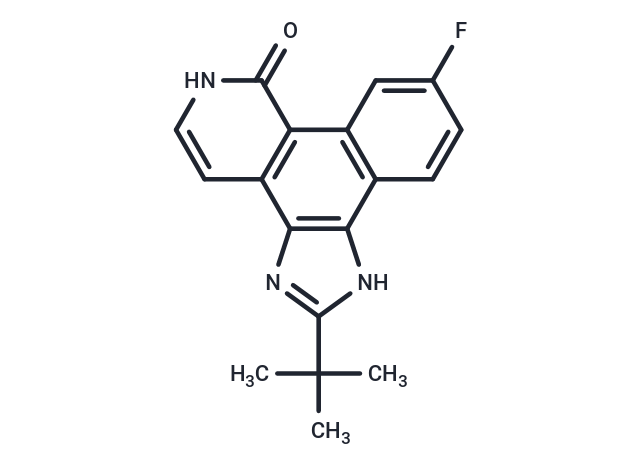Shopping Cart
Remove All Your shopping cart is currently empty
Your shopping cart is currently empty
Pyridone 6 (JAK Inhibitor)(CMP 6) is a potent and selective inhibitor of JAK1 (IC50=15 nM, murine JAK1), JAK2 (IC50=1 nM), JAK3 (Ki=5 nM), and Tyk2 (IC50=1 nM); displaying significantly weaker affinities (130 nM to 10 mM) for other protein tyrosine kinases.

| Pack Size | Price | USA Warehouse | Global Warehouse | Quantity |
|---|---|---|---|---|
| 1 mg | $48 | In Stock | In Stock | |
| 2 mg | $68 | In Stock | In Stock | |
| 5 mg | $113 | In Stock | In Stock | |
| 10 mg | $193 | In Stock | In Stock | |
| 25 mg | $397 | In Stock | In Stock | |
| 50 mg | $652 | - | In Stock | |
| 100 mg | $987 | - | In Stock | |
| 200 mg | $1,330 | - | In Stock | |
| 1 mL x 10 mM (in DMSO) | $118 | In Stock | In Stock |
| Description | Pyridone 6 (JAK Inhibitor)(CMP 6) is a potent and selective inhibitor of JAK1 (IC50=15 nM, murine JAK1), JAK2 (IC50=1 nM), JAK3 (Ki=5 nM), and Tyk2 (IC50=1 nM); displaying significantly weaker affinities (130 nM to 10 mM) for other protein tyrosine kinases. |
| Targets&IC50 | Csk:2.1 μM, FGFR:1.48 μM, JAK1:15 nM, MAPK:1.78 μM, cAMP stimulated protein kinase:7.1 μM, FLT4:0.69 μM, Hck:7.7 μM, KDR:1.4 μM, JAK3:5 nM(Ki), TYK2:1 nM, FGFR2:0.94 μM, Tek:24 μM, IκB Kinase 2:0.3 μM, PDGFR:1.49 μM, PKCα:1.2 μM, FLT1:1.52 μM, p38:11 μM, Fyn T:0.5 μM, JAK2:1 nM, CDK2:3.3 μM, MEK:0.16 μM |
| In vitro | Pyridone 6 (P6) is shown to inhibit kinase by interacting within the ATP-binding cleft of each JAK. The IC50 of Pyridone 6 is 3 nM for all of these cytokines; this is comparable to the reported IC50s of Pyridone 6 for JAK2, Tyk2, and JAK3. Pyridone 6 strongly inhibits Th2 and modestly inhibits Th1, whereas it enhances Th17 development when present within a certain range of concentrations. Pyridone 6 reduces IFN-γ and IL-13, whereas it enhances IL-17 and IL-22 expression. Pyridone 6 also inhibits both Th1 and Th2 development, whereas it promotes Th17 differentiation from naive T cells when present within a certain range of concentrations[1]. Pyridone 6 inhibits osteoclast differentiation in mouse bone marrow macrophage (BMM) cultures stimulated by the receptor activator of nuclear factor-k B (NF-k B) ligand (RANKL) and co-cultures of bone marrow cells and osteoblasts. Pyridone 6 suppresses the expression of c-Fos and nuclear factor of activated T cells (NFAT) c1 in BMMs. Pyridone 6 also suppresses I-k B degradation and extracellular signal-regulated kinase (ERK) in mature osteoclasts, suggesting that these are the key molecules that pyridone 6 targets in the inhibition of osteoclast function[2]. Pyridone 6 (P6), is found to inhibit the JAKs in the low nanomolar range (IC50, 1-15 nM) and blocks IL-2-dependent proliferation of CTLL cells. Pyridone 6 is a reversible ATP inhibitor, and when tested against many other kinases, IC50s of >130 nM are required[3]. |
| In vivo | Pyridone 6 (P6) postpones the initiation and diminishes the severity of skin conditions in an AD-like model using NC/Nga mice, effectively mitigating atopic dermatitis (AD) symptoms. Its efficacy is on par with betamethasone ointment, a standard treatment, also serving as a positive control. Conversely, empty PLGA nanoparticles (C-nano) appear ineffective[1]. |
| Kinase Assay | Kinase Assays: Baculovirus-expressed glutathione S-transferase-tagged proteins encoding the intracellular domain of IGF-1R (amino acids 957-1367) and IR (amino acids 979-1382) are used for determinations of IC50s by a homogeneous time-resolved fluorescence assay. A filter binding assay is used for appKi determinations using activated IGF-1R and IR kinases. Expanded kinase-selectivity profiling of GSK1838705A is carried out by screening the compound in the KinaseProfiler panel. |
| Cell Research | Pyridone 6 (P6) is prepared in DMSO and stored, and then diluted with appropriate medium before use[1]. Naive CD4+ T cells are treated with various concentrations of Pyridone 6 in RPMI 1640 medium 1 h before the appropriate cytokines are added to create each Th-differentiating condition. Immunoblotting is performed using antiphospho-STAT protein Abs or anti-total STAT protein Abs[1]. |
| Synonyms | Janus-Associated Kinase Inhibitor I, JAK Inhibitor I, JAK I inhibitor, CMP 6 |
| Molecular Weight | 309.34 |
| Formula | C18H16FN3O |
| Cas No. | 457081-03-7 |
| Smiles | CC(C)(C)c1nc2c([nH]1)c1ccc(F)cc1c1c2cc[nH]c1=O |
| Relative Density. | 1.328 g/cm3 |
| Storage | Powder: -20°C for 3 years | In solvent: -80°C for 1 year | Shipping with blue ice/Shipping at ambient temperature. | |||||||||||||||||||||||||
| Solubility Information | DMSO: 12 mg/mL (38.79 mM), Sonication is recommended. | |||||||||||||||||||||||||
| In Vivo Formulation | 10% DMSO+40% PEG300+5% Tween 80+45% Saline: 2 mg/mL (6.47 mM), Sonication is recommended. Please add the solvents sequentially, clarifying the solution as much as possible before adding the next one. Dissolve by heating and/or sonication if necessary. Working solution is recommended to be prepared and used immediately. The formulation provided above is for reference purposes only. In vivo formulations may vary and should be modified based on specific experimental conditions. | |||||||||||||||||||||||||
Solution Preparation Table | ||||||||||||||||||||||||||
DMSO
| ||||||||||||||||||||||||||
| Size | Quantity | Unit Price | Amount | Operation |
|---|

Copyright © 2015-2025 TargetMol Chemicals Inc. All Rights Reserved.